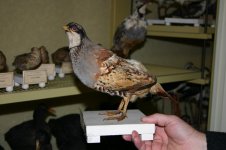Gonçalo Elias
avesdeportugal.info

Hi all,
While studying birds of Portugal at the Natural History Museum of the University of Coimbra, I found this very strange partridge (pic below).
According to the label, the bird was collected in the Coimbra area on Dec 23rd, 1946.
Please note that another odd individual is visible in the background.
Could these birds be hybrids? Some sort of mutation? Any thoughts shall be welcome.
Thanks,
Gonçalo
While studying birds of Portugal at the Natural History Museum of the University of Coimbra, I found this very strange partridge (pic below).
According to the label, the bird was collected in the Coimbra area on Dec 23rd, 1946.
Please note that another odd individual is visible in the background.
Could these birds be hybrids? Some sort of mutation? Any thoughts shall be welcome.
Thanks,
Gonçalo





